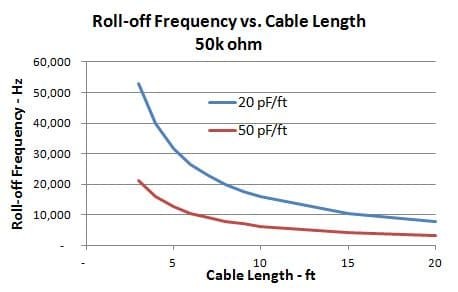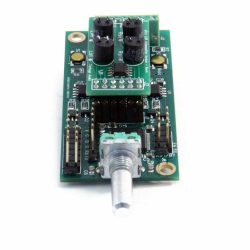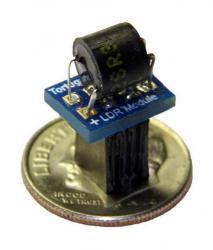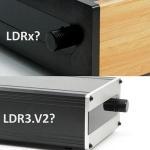Is a Passive Preamp Right For You?
The Passive vs. Active Debate
More and more audiophiles and DIY audio enthusiasts are discovering the benefits of passive preamps. Why? Because more often than not, a passive preamp does the essential job of a preamp (input switching and controlling volume) while doing the least amount of harm to the audio signal.
Still, the debate over passive vs. active preamps mushes on within the audio community with the prevailing wisdom being that an active preamp is better than any/all passive preamps. Is this really true? As with so many things in life the answer is….it depends.
Just as all active preamps are not the same, the performance of passive preamps can range from just ok to exceptional.
Let’s explore this a little further.
What is a Passive Preamp?
If preamps were mechanical devices you might think of active preamps as being analogous to a V8 engine. Lots of parts. Complex. Powerful. But what comes out may not be what went in. And you might have picked up some sonic artifacts and color along the way. Some like that.
On the other hand, a passive is more like a converging/diverging nozzle. Simple throttle. Few parts. And best of all what comes out is pretty much what went in. Personally, I like the thought of that. I want to listen to the music, not the hardware.
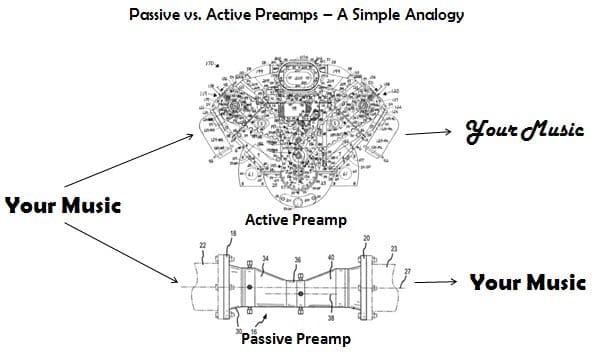
What is meant by “passive” anyway? Among the audio cognoscenti, even the term “passive” can engender earnest debate.
For purposes of this article, the term “passive” simply means that there’s no deliberate involvement by a power source (if there is one) to either amplify or buffer the audio signal. In most cases that means the audio signal only passes through some form of variable resistor to control the volume. Examples of variable resistors include potentiometers, resistor ladders, or in the case of Tortuga Audio, light dependent resistors (LDRs). More information can be found in our online documentation on light dependent resistors. And then there are also transformer based passives where the audio signal is actually conveyed and attenuated electromagnetically.
What is beyond debate is that “passive” preamps do not amplify at all, “pre” or otherwise. So why call it a preamp? Well it still comes before the amplifier so “pre” still makes sense, lack of amplification notwithstanding. And somehow calling it a “passive volume controller” just doesn’t satisfy….but that’s what passive preamps really are.
Passive preamps usually do these 2 things:
- Provide volume control (attenuation) – a must!
- Switch between multiple inputs – optional!
What is an Active Preamp?
By comparison, most conventional “active” preamps do two additional things that passive preamps do not:
- Amplify the audio signal (they have “gain”)
- Provide an electronic preamp buffer between the signal source and your amplifier
Amplification involves power supplies, capacitors, tubes and/or op amps etc. all of which means additional “messing with the audio signal” – which rarely provides net improvement. Some active preamps come with a bypass switch that allow the input signal to bypass all that active circuitry. It’s fair to say that no active preamp sounds the same when it’s bypassed vs. when it’s active. Why? Because all of that active circuitry is modifying the audio signal. We’ll get back to this topic later on below.
Most active preamps have some amount of gain which simply means the they can increase the voltage level of the incoming audio signal which translates directly into increasing the maximum available volume level.
Regardless of the level of gain (or absence of gain, i.e. unity gain), all active preamps buffer the input from the output. A buffer acts as an electronic firewall between the source and the amp. A good buffer has very high input impedance making the job of the source very easy. Easy means the source puts out very little current while sending out the audio signal (i.e. voltage). Conversely, a good buffer has very low output impedance and high current delivery capacity making it compatible with virtually every amplifier in the world regardless of the amp’s input impedance. This broad compatibility is arguably the only benefit of active preamps. A good buffer can enhance the dynamics (pluck, punch, slam etc.) of the music if the source isn’t quite up to the job.
Why Passives?
The simplicity of a passive preamp has the inherent appeal of the “less is more” school of audio design. Enough, but not more than enough, is arguably the right design philosophy when dealing with audio signals. But that’s a bit vague so let’s drill down a bit.
You Don’t Need The Gain
Chances are quite good that you probably don’t need any pre-amplification before your amplification. Most audio sources today (CD transport, DACs, phono stages etc. ) have adequate line stage output voltage and most amps have sufficient input sensitivity and power. You don’t need to amplify the audio signal twice.
You Don’t Need The Added Color
Active preamps always add their own color to the audio signal. Perhaps you like that color. On the other hand, why not listen to the recording as it was intended with less meddling by your audio reproduction gear. What does less meddling mean? Less connectors, less circuits, less manipulation, less distortion, less noise, less hum, less coloration, less cross talk, less phase shift, less compression. Less bad. By comparison, passives add little or no coloration of their own. Our Tortuga Audio LDR passive preamps are distinctly color-free!
Your Source Can Deliver The Goods
Most contemporary sources are able to easily deliver the audio signal to the amplifier through a passive preamp with excellent dynamics and overall sound quality. The blanket notion that you must have a buffered preamp for great sound is simply not supported by the evidence.
Passives Sound Better
Simply put, where suitable, a good passive preamp will sound better than most active preamp and as good as the best high-end active preamps costing many thousands of dollars more. However, just like active preamps, passive preamps don’t all sound the same and some are far better than others. We believe our Tortuga Audio LDR passe preamps are the best sounding passives money can buy today.
Passives Cost Less
Eliminating all that active circuitry and manipulation of the audio signal results in far fewer parts and thus lowers the cost. The best passive available today can easily cost 70-80% less than a top of the line active preamp.
Why Not Passives?
Will a passive always outperform an active preamp? Simply put, no. There will be always be exceptions where the combination of source and amp simply are not a good fit. Here are the two most common issues.
Impedance Mismatch
Using a passive preamp between a high impedance source and a low impedance amp may overwhelm the ability of the source to drive the audio signal without negative effects. Negative effects like flabby sound lacking in dynamics and punch.
On the other hand its been our experience (and more important that of our customers) that this rarely happens with our LDR passive preamps. An impedance ratio of 100:1 or greater (amp input : source output) is almost certain to work well with passive preamps. For example, a DAC with a 500 ohm output impedance and a solid state amp with a 50k ohm input impedance all but certain to be a good match for a passive preamp. Passive preamps will also work well with practically any tube amp because tube amps have very high input impedances (typically 1 megaohm).
Note that as of January 1, 2015 all Tortuga Audio LDR passive preamps have adjustable impedance that allows the user to configure the impedance matching (or bridging) for optimal sonic performance. More information on adjustable impedance is available here.
Low Source Voltage
Closely interrelated with the impedance issue, the source has to have sufficient line voltage and currently delivery capacity to drive the audio signal through the added resistance of the passive preamp and into the amp. The good news is most quality audio sources today have strong enough line voltages (~2 volts) to work fine with most passive preamps.
High Cable Capacitance
Since a passive preamp can add considerable impedance to the audio signal, the total capacitance of the interconnect cables can conspire with the cable/preamp resistance to act as a low pass filter that rolls-off the higher frequency signals in the audible range. Let’s elaborate.
The issue with cable capacitance is easier to grasp visually that with a jumble of formulas. I refer you to the graphic below.
Assuming a passive preamp with a nominal 50k ohm input impedance, the influence of cable length and capacitance becomes quite relevant. If we examine the graph below, we see the roll-off frequency plotted against interconnect cable length for cable of 2 difference capacitance values per foot. Our goal is to stay comfortably above 20,000 Hz so we don’t lose any of the high frequencies or get excessive phase shift.
With high capacitance cable of 50 pF/ft, the cable should be no longer than 3 feet to avoid cutting off audio signals below 20kHz (the upper limit of human hearing).
With lower capacitance cable of say 20 pF/ft, we can use an 8 foot long cable before we start rolling off the high frequencies. Clearly, shorter is better and lower capacitance cable is better.
While technically correct and perhaps a bit daunting to absorb the practical reality is that cabling is rarely the key limiting issue with passive preamps. In our own experience with hundreds of our LDR passive preamps and customers not a single issue has come up related to cabling and signal roll-off. We even had one reviewer who used 25 foot cables (despite our caution against this) and yet was very pleased with the results and found no reason to rearrange his audition equipment.
It should come as no surprise that you can find audio enthusiasts with disappointing stories about the time they tried a passive preamp. And they’ll tell you that passive preamps don’t work well with the conviction born of experience. While their experience informs their views there’s an abundance of audio enthusiasts with nothing but positive things to say about their experience with passive preamps.
Many of Tortuga Audio’s customers have owned both active preamps and other brands of passive preamps. They universally praise our LDR passive preamps as the best they’ve every heard.
Conclusions?
- Passive preamps can sound better than most active preamps and as good as even the best active preamp costing thousands of dollars more.
- Passive preamps benefit from shorter and/or lower capacitance interconnect cables between the preamp and the amp. But don’t get too worried about this. Just try to keep downstream interconnects to 6 feet or less. Upstream cable length doesn’t matter.
- Passive preamps work well with most amps provided the impedance differential between amp and source are approximately 100:1. This isn’t a hard and fast rule. We’ve seen great results with 50:1 and even less. It depends on your particular equipment. .
- If you experience disappointing results with a passive preamp, chances are it’s due to one or more of the issues cited above. All these impediments can be mitigated with the right equipment and cabling.
- In most cases the benefits of passive preamps makes it worth the effort to secure compatible equipment. Eliminating the complexity of an active preamp can be worth the effort.
Tortuga Audio supports a generous 30 day buy-and-try audition policy with 100% refund (less shipping cost). Tell us about your sources and amp we’ll tell you if we think our passives will work with your gear or not.
Ultimately, all the analyses, anecdotes and guidelines in the world are no substitute for hearing it and deciding for yourself. Of course we believe our LDR based preamps are nothing less than some of the best sounding preamps available today regardless of type, brand or cost.
More Information
More information on our LDR passive preamps can be found via the links below.

